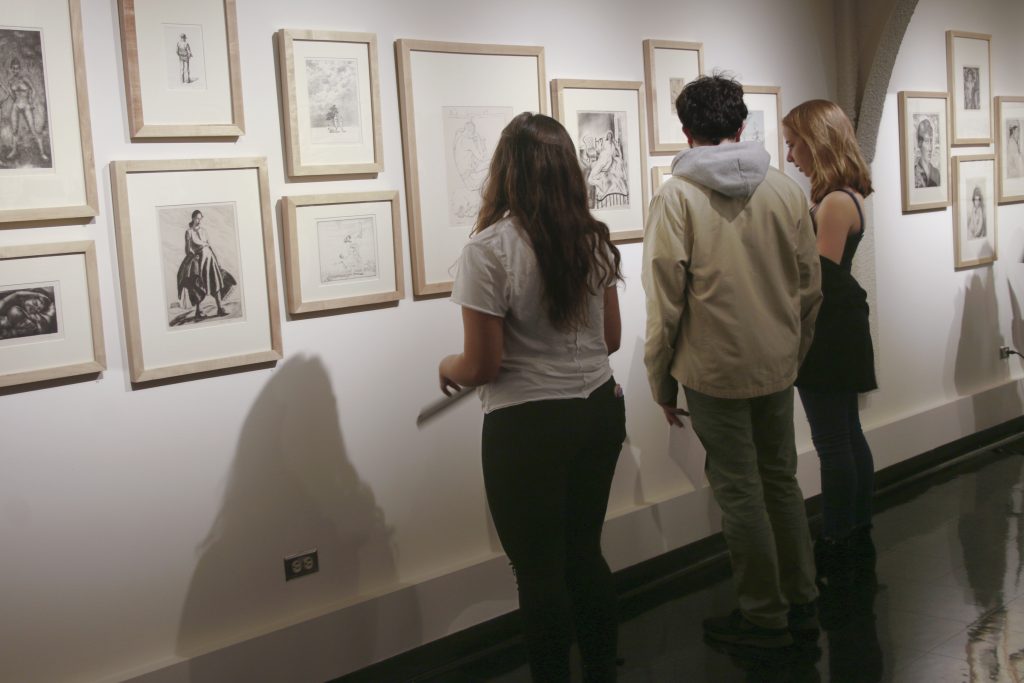
Capturing the complexity of life in two dimensions is challenging, but for the artists featured in the Binghamton University Art Museum’s new show, paper offered the perfect medium.
“Works on Paper Between the Wars” features prints and drawings of life made between World War I and World War II. Pieces for the show were donated by Gil and Deborah Williams and were celebrated in an opening on Thursday at the University Art Museum. The Binghamton residents donated over 400 works from their private collection, approximately 100 of which are now on display in the main gallery, located in the Fine Arts Building.
The show offers a glimpse into many facets of life in the ’20s, ’30s and ’40s, and pieces are grouped by theme rather than categorized by artist or timeline. Additionally, each wall in the gallery is titled with a singular word, such as “home,” “faces,” “work” and “play.”
Diane Butler, director of the University Art Museum, spoke about the unique task of incorporating so many styles and genres into the exhibit.
“It was a challenge for us to design, because you want things to have contrast but not fight too much,” said Butler, who has been at the helm of the museum for five years.
The images reflect a distinct sense of nostalgia, recalling the many American lives that were uprooted during the time following the World War I and the Great Depression. The categories of subject matter reflect what was relevant in the era, and the section titled “work” is given particular prominence.
“It seemed right to have ‘work’ as the middle of the wheel, with the other categories serving as spokes,” Butler said. “The artists were able to work during the Great Depression and make some money. That was a wonderful power of the federal government, and [it] is still very important for the federal government to continue to support institutions like the National Endowment for the Arts and National Endowment for the Humanities.”
The main gallery is accompanied by an exhibition titled “Fashionable Impressions” on the mezzanine level, which is a collaboration between the museum and costume designers in the theatre department. Vintage clothing from the era has been paired with one or multiple works of art from the same period. In the lower galleries, four smaller exhibits are on display, three of which are curated by students.
Music students also performed as a part of the gallery’s opening. On Thursday evening, members of assistant professor Daniel Davis’ fall MUS 331: Composition I class played pieces they had composed using images from the Williams’ collection as inspiration.
“One of our final projects was to write a piece, and we were given access to the collection and each picked a work of art to compose music about,” said Matthew Zehnbauer, who took the class and is a senior double-majoring in physics and music. “I chose to overlay my piece, ‘Beauty of the Flower,’ with a quote from the physicist Richard Feynman, and it’s based on an image of a violinist.”
This is the third time Butler has collaborated with Davis and the music department to host a student performance in the museum.
“The delight of coming to the performance is that some students go down some very distinctive paths with their projects, whether it’s using electronic music or orchestration,” Butler said. “That is their creative endeavor. It’s so nice that a work of art can inspire another work of art.”
Nearly 270 people visited the gallery during the two-hour opening, some of which were members of the local community.
“I’m a big fan of Diane Butler, and I think what she’s doing at the University is really wonderful,” said Mary Webster, a Binghamton area resident and local business owner. “I appreciate all the collaboration with the music department, and also the way in which she involves the students in curating the exhibitions is great, and I like to support that.”
On Feb. 16, at noon, Gil Williams will hold a public discussion with Diane Butler. He will share histories about the works on display and talk about his experience meeting and interviewing many of the artists during the ‘70s and ‘80s. The exhibit will be open until March 31.


